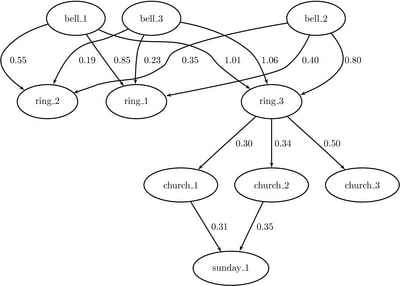The OPTGRAPH Procedure
- Overview
-
Getting Started

-
Syntax
 Functional SummaryPROC OPTGRAPH StatementBICONCOMP StatementCENTRALITY StatementCLIQUE StatementCOMMUNITY StatementCONCOMP StatementCORE StatementCYCLE StatementDATA_LINKS_VAR StatementDATA_MATRIX_VAR StatementDATA_NODES_VAR StatementEIGENVECTOR StatementLINEAR_ASSIGNMENT StatementMINCOSTFLOW StatementMINCUT StatementMINSPANTREE StatementPERFORMANCE StatementREACH StatementSHORTPATH StatementSUMMARY StatementTRANSITIVE_CLOSURE StatementTSP Statement
Functional SummaryPROC OPTGRAPH StatementBICONCOMP StatementCENTRALITY StatementCLIQUE StatementCOMMUNITY StatementCONCOMP StatementCORE StatementCYCLE StatementDATA_LINKS_VAR StatementDATA_MATRIX_VAR StatementDATA_NODES_VAR StatementEIGENVECTOR StatementLINEAR_ASSIGNMENT StatementMINCOSTFLOW StatementMINCUT StatementMINSPANTREE StatementPERFORMANCE StatementREACH StatementSHORTPATH StatementSUMMARY StatementTRANSITIVE_CLOSURE StatementTSP Statement -
Details
 Graph Input DataMatrix Input DataData Input OrderParallel ProcessingNumeric LimitationsSize LimitationsCommon Notation and AssumptionsBiconnected Components and Articulation PointsCentralityCliqueCommunityConnected ComponentsCore DecompositionCycleEigenvector ProblemLinear Assignment (Matching)Minimum-Cost Network FlowMinimum CutMinimum Spanning TreeReach (Ego) NetworkShortest PathSummaryTransitive ClosureTraveling Salesman ProblemMacro VariablesODS Table Names
Graph Input DataMatrix Input DataData Input OrderParallel ProcessingNumeric LimitationsSize LimitationsCommon Notation and AssumptionsBiconnected Components and Articulation PointsCentralityCliqueCommunityConnected ComponentsCore DecompositionCycleEigenvector ProblemLinear Assignment (Matching)Minimum-Cost Network FlowMinimum CutMinimum Spanning TreeReach (Ego) NetworkShortest PathSummaryTransitive ClosureTraveling Salesman ProblemMacro VariablesODS Table Names -
Examples
 Articulation Points in a Terrorist NetworkInfluence Centrality for Project Groups in a Research DepartmentBetweenness and Closeness Centrality for Computer Network TopologyBetweenness and Closeness Centrality for Project Groups in a Research DepartmentEigenvector Centrality for Word Sense DisambiguationCentrality Metrics for Project Groups in a Research DepartmentCommunity Detection on Zachary’s Karate Club DataRecursive Community Detection on Zachary’s Karate Club DataCycle Detection for Kidney Donor ExchangeLinear Assignment Problem for Minimizing Swim TimesLinear Assignment Problem, Sparse Format versus Dense FormatMinimum Spanning Tree for Computer Network TopologyTransitive Closure for Identification of Circular Dependencies in a Bug Tracking SystemReach Networks for Computation of Market Coverage of a Terrorist NetworkTraveling Salesman Tour through US Capital Cities
Articulation Points in a Terrorist NetworkInfluence Centrality for Project Groups in a Research DepartmentBetweenness and Closeness Centrality for Computer Network TopologyBetweenness and Closeness Centrality for Project Groups in a Research DepartmentEigenvector Centrality for Word Sense DisambiguationCentrality Metrics for Project Groups in a Research DepartmentCommunity Detection on Zachary’s Karate Club DataRecursive Community Detection on Zachary’s Karate Club DataCycle Detection for Kidney Donor ExchangeLinear Assignment Problem for Minimizing Swim TimesLinear Assignment Problem, Sparse Format versus Dense FormatMinimum Spanning Tree for Computer Network TopologyTransitive Closure for Identification of Circular Dependencies in a Bug Tracking SystemReach Networks for Computation of Market Coverage of a Terrorist NetworkTraveling Salesman Tour through US Capital Cities - References
Example 1.5 Eigenvector Centrality for Word Sense Disambiguation
In many languages, numerous words are polysemous (they carry more than one meaning). A common task in information retrieval is to assign the correct meaning to a polysemous word within a given context. Take the word "bass" as an example. It can mean either a type of fish (as in the sentence "I went fishing for some sea bass") or tones of low frequency (as in the sentence "The bass part of the song is very moving").
The following example from Mihalcea 2005 shows how eigenvector centrality can be used to disambiguate the word sense in the sentence "The church bells no longer ring on Sundays." The following senses of words can be drawn from a dictionary:
-
church
-
one of the groups of Christians who have their own beliefs and forms of worship
-
a place for public (especially Christian) worship
-
a service conducted in a church
-
-
bell
-
a hollow device made of metal that makes a ringing sound when struck
-
a push button at an outer door that gives a ringing or buzzing signal when pushed
-
the sound of a bell
-
-
ring
-
make a ringing sound
-
ring or echo with sound
-
make (bells) ring, often for the purposes of musical edification
-
-
Sunday
-
first day of the week; observed as a day of rest and worship by most Christians
-
Using one of the similarity metrics defined in Sinha and Mihalcea 2007, you can generate a graph in which the nodes correspond to the word senses given above and the weights are determined by the similarity metric. The resulting graph is shown in Figure 1.143.
Figure 1.143: Eigenvector Centrality for Word Sense Disambiguation

To identify the correct senses, you run eigenvector centrality on the graph and select the highest ranking sense for each word:
data LinkSetIn;
input from $ to $ weight;
datalines;
bell_1 ring_1 0.85
bell_1 ring_2 0.55
bell_1 ring_3 1.01
bell_2 ring_1 0.40
bell_2 ring_2 0.35
bell_2 ring_3 0.80
bell_3 ring_1 0.23
bell_3 ring_2 0.19
bell_3 ring_3 1.06
ring_3 church_1 0.30
ring_3 church_2 0.34
ring_3 church_3 0.50
church_1 sunday_1 0.31
church_2 sunday_1 0.35
;
proc optgraph
data_links = LinkSetIn
out_nodes = NodeSetOut;
centrality
eigen = weight;
run;
data NodeSetOut;
length word $8 sense $1;
set NodeSetOut;
word = scan(node,1,'_');
sense = scan(node,2,'_');
run;
proc sort
data = NodeSetOut
out = WordSenses;
by word descending centr_eigen_wt;
run;
data WordSenses;
set WordSenses(drop=centr_eigen_wt);
by word;
if first.word then output;
run;
The eigenvector scores and the implied word sense are shown in Output 1.5.1.
Output 1.5.1: Eigenvector Centrality for Word Sense Disambiguation